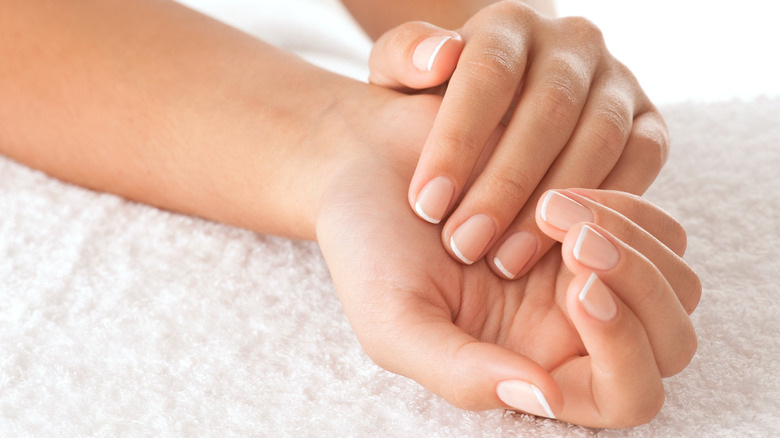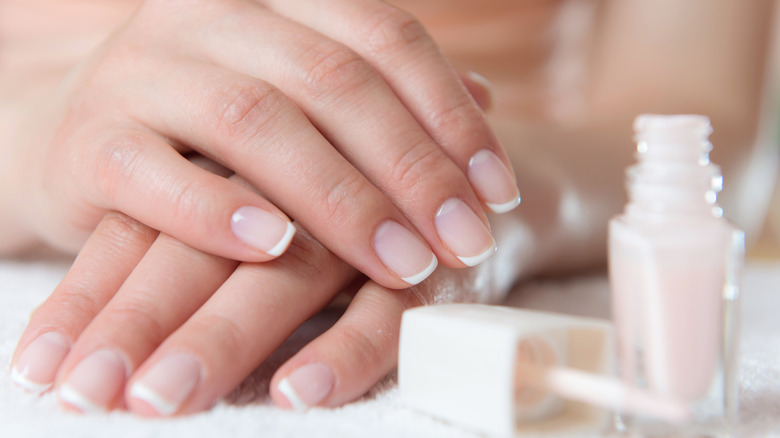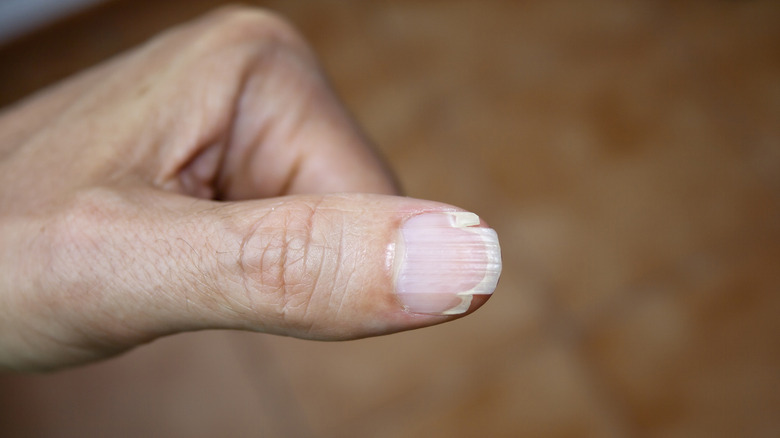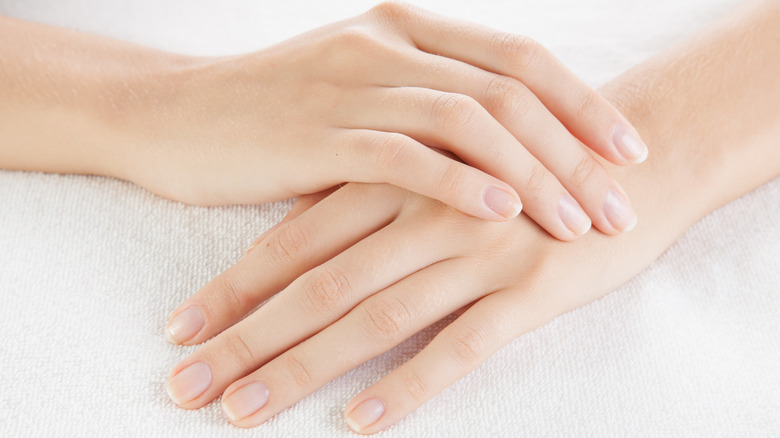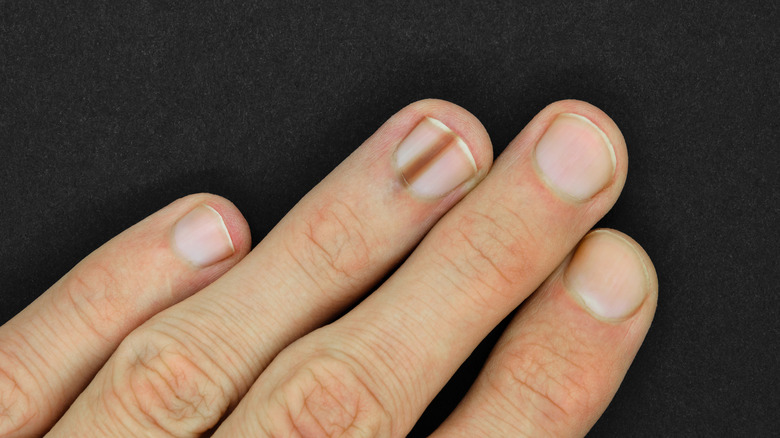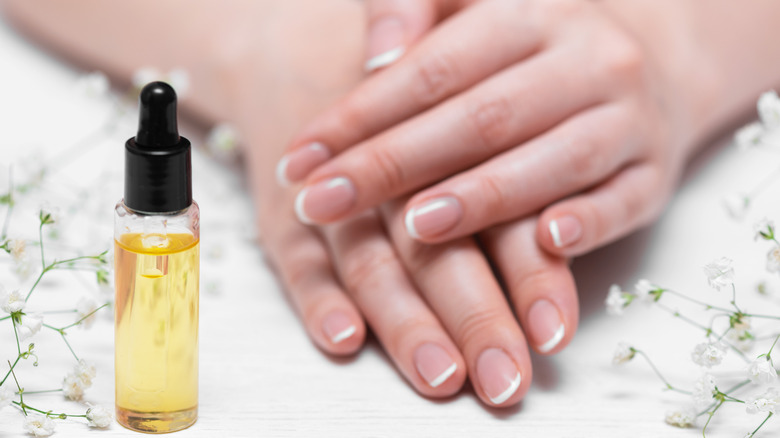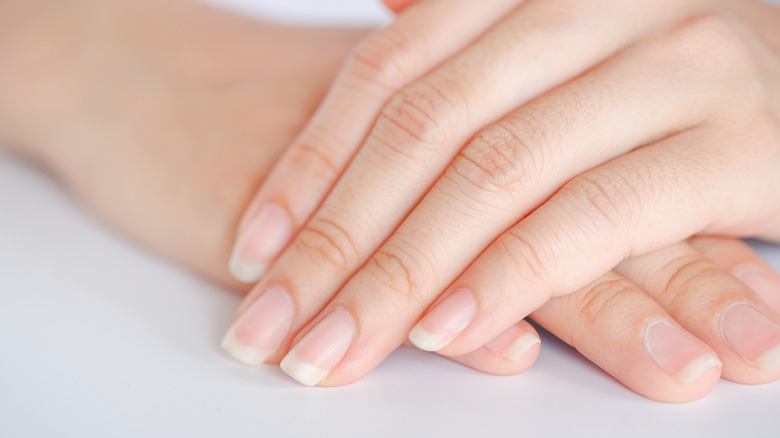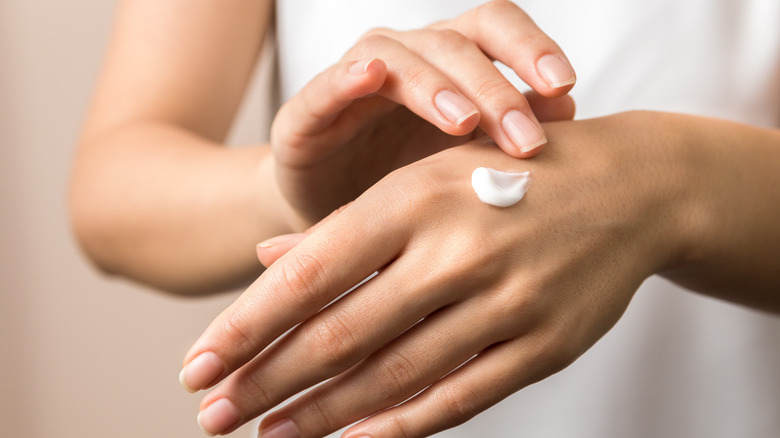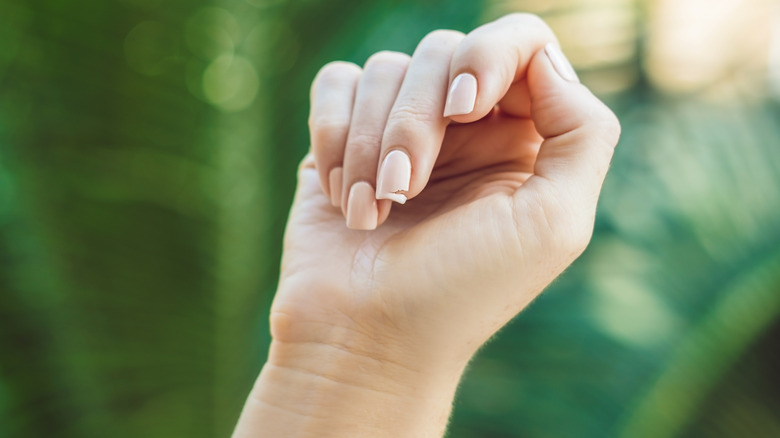How To Tell If Your Nails Are Actually Healthy Or Not
Nails are not just a space to fill with colorful polishes and designs. Their purpose is to protect the tops of your fingers and toes. They even help you to pick things up. For your nails to do their job properly, they need to be healthy. However, changes in their color, texture, and strength can also warn you of underlying health issues. Before you can keep an eye on your nails and know when something looks wrong, you need to differentiate the different parts that make up the tips of your fingers.
When you look at your nail, you're really looking at the nail plate with the nail bed underneath it. This is the hard keratin that grows out of your finger. Once it passes the end of your finger and appears white, it's called the free edge. Nail Pro explains that your nail grows from the matrix. It has nerves and blood vessels, which produce new cells to replace the hard ones on your nail plate. The matrix is at the bottom of your nail by the lunula, also known as the half-moon. This area is a different color than the rest of your nail because it's where the new cells harden and become the plate. Near this area are your eponychium and cuticle, which protect your nail from bacteria by sealing it.
Opaque lunula
Your lunula is the half-moon at the bottom of your nails. It's usually most visible on your thumb and very tiny on your pinky. Some people don't have this feature on one or all of their fingers — but if you do, it should be an opaque white color. If you notice your lunula appears different than usual, it can be a sign that your nails (and possibly your entire body) aren't healthy. Healthgrades explains that you don't need to be concerned unless you're also experiencing other symptoms. Sometimes your nails can be the final warning sign that it's time to see a doctor.
The color of your lunula can help your physician diagnose you with a potential health condition. If the half-moon on your nail looks blue-purple, you may have poor blood circulation. While brown is associated with chronic kidney disease, red can signify heart failure and cardiovascular disease.
No cracks or splits
Cracks or splits in your nails indicate that they aren't healthy. They usually occur if your nail plates aren't getting enough moisture. Washing your hands a lot without applying lotion and frequently getting manicures can dry out your nails to the point that they split. When they split vertically, from your cuticle to the tip of your nail, it's called onychorrhexis.
Another reason why you may be suffering from splits is if you lack iron, vitamin B, or biotin in your diet, explains Doctors Kline + Green. Luckily, there are ways for you to treat onychorrhexis and make your nails healthy again. Once you change to a balanced diet or add supplements after consulting your physician, you should see a change in your nails. However, if they are splitting because they lack moisture, you can solve the problem by soaking your nails in water and using hand cream.
Smooth nail plate
You can develop ridges in your nails going vertically or horizontally, which will mean different things. Most of the time, they are a side effect of aging. But they can also be a sign of a health problem. Vertical ridges are called bands and run from the cuticle to the tip of the nail. You may notice some bands as you grow older because your skin cell production slows down as you age. Nails are affected by this because not all your dead cells are being replaced by new ones. These vertical ridges can be a sign of an iron deficiency.
Meanwhile, horizontal ridges are also known as Beau's lines. They can signify acute kidney disease, mumps, or a zinc deficiency. Healthline explains that if you wait long enough without treating the issue causing the ridges, your nails may temporarily stop growing. If your nail went through trauma and you notice ridges, you may want to wait for it to heal before being concerned or seeing a physician about underlying health issues.
No dark lines
Dark lines running from the cuticle to the tip of your nail may mean they aren't healthy. This depends on if you've always had these lines and if you have any other symptoms. Sometimes dark lines are normal. They're also called melanonychia and happen when excess pigment is made in the nail. The color of the lines can range from black to grey and even brown. Melanonychia is most common in African-American people over the age of 20, according to Medical News Today. This is one of the cases where dark lines on your nail aren't a sign of being unhealthy.
If you're also experiencing painful nails that bleed without any reason, you may have an underlying health problem. Your nails may indicate melanomas, lupus, HIV, or a side effect of some medications. Splinter hemorrhages also cause lines going down the nail, but they will be black or red. This usually happens after you've injured your nail because the blood vessels under the nail plate have broken.
Hydrated cuticles
Your cuticles are an essential part of your nail's health. They should look like a thin line of transparent skin between your nail and the skin of your fingers. Technically, this is named the eponychium, but it is commonly called the cuticle. If it's bleeding or looks cracked and dry, you have an unhealthy cuticle. The most common cause is from over-washing your hands or hand sanitizer and biting your nails or cuticles. However, it can also come from malnutrition, eczema, or as a side effect of some medications.
Dermatologist Zain Hussain, M.D. explained to Yahoo that you only need to be concerned if your cuticles are inflamed and in pain. If that's the case, see your physician. Otherwise, you should use cuticle oil and hand cream to add moisture back to your cuticles. Nail biting may be hard to quit since most people do it to relieve stress and anxiety – but it is worth having healthier nails.
Flesh colored nails
The color of your nail plates is a big sign of the state of your overall health. They should be flesh-colored and white at the tips with a bit of shine over them, according to netmeds.com. Depending on the color of your nails, you may have a health condition. If the entire nail is white instead of just the tip, there may be a problem with your kidneys or liver. However, if you only have white spots and haven't injured your nail recently, you may be deficient in zinc or iron.
A yellow nail is a sign of fungus or tobacco use, while a green color can mean you have a bacterial infection. Like with your lunula, a blue-purple color means you aren't getting enough oxygen in your blood. Black signals a bacterial infection, B12 deficiency, or kidney and liver disease. Meanwhile, if your nail has a grey undertone, it could be from malnutrition, arthritis, glaucoma, or lung problems.
No irritation on your skin
The skin around your nails can also affect the health of your nails. Its job is to prevent infection, but harmful bacteria can enter if your skin starts peeling. The peeling can happen for many different reasons, and if you let it continue, it will also affect your cuticles. Lybrate explains that nail and cuticle biting is the most common cause of irritation around your nail. However, there are medical problems that will dry the skin out and lead to bacterial or fungal infections.
Psoriasis and eczema are skin conditions that will affect this area. Being deficient in vitamin B-3 or calcium is another reason why this would happen. A less severe cause is that you may be drying out your hands from washing them too much. If you've quit biting your nails and tried using more moisturizer, consult your physician to see if a vitamin deficiency keeps your nails from being healthy.
Flexible and strong
Healthy nails are flexible and strong. They may chip or break every once in a while, but only when grown. Nails can weaken for a variety of reasons. Dermatologist Rhonda Klein, M.D. told Prevention that as people get older, their bodies don't produce cells at the same rate as when they were young. This makes nails dry and weak. It can be from extreme dryness if you're still young and find it almost impossible to grow out your nails without them breaking. Leaving your hands exposed to winter weather and excessively washing them can cause your nails to dry out.
If your nails break from dryness, you can solve the issue with moisturizer and cuticle oil. You should use hand cream after you wash your hands and frequently in the winter. Staying away from nail polish remover with acetone will prevent them from breaking since it draws moisture out of your nail plate. Over-the-counter nail strengtheners can also help.
